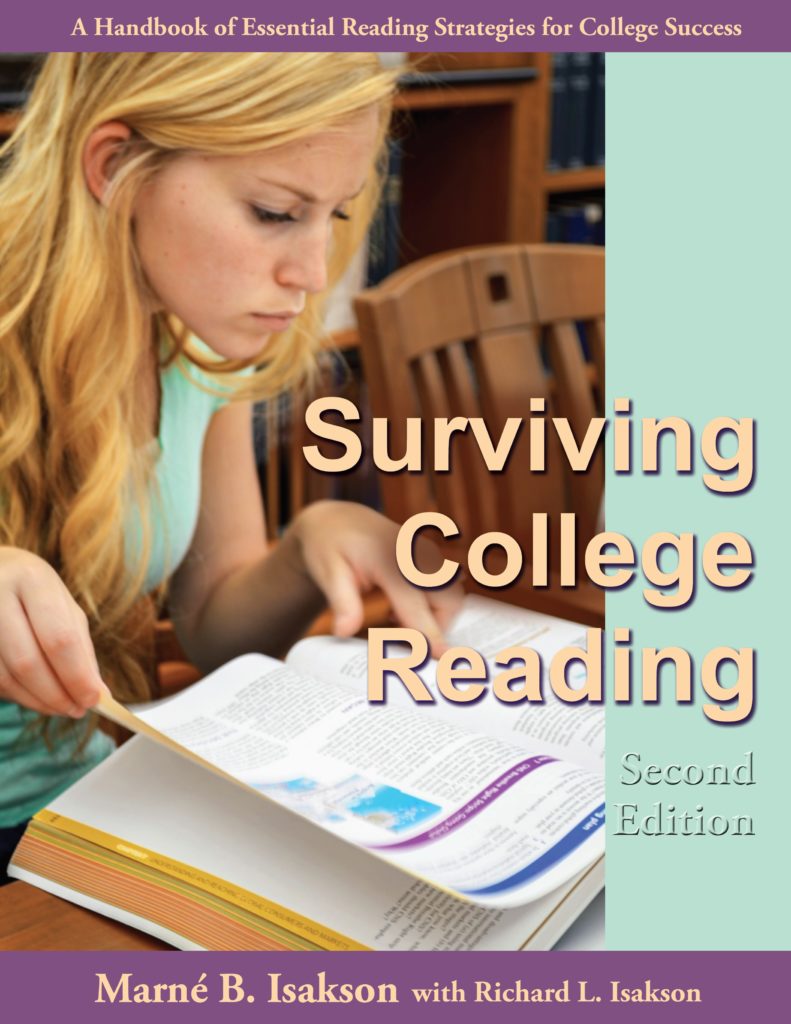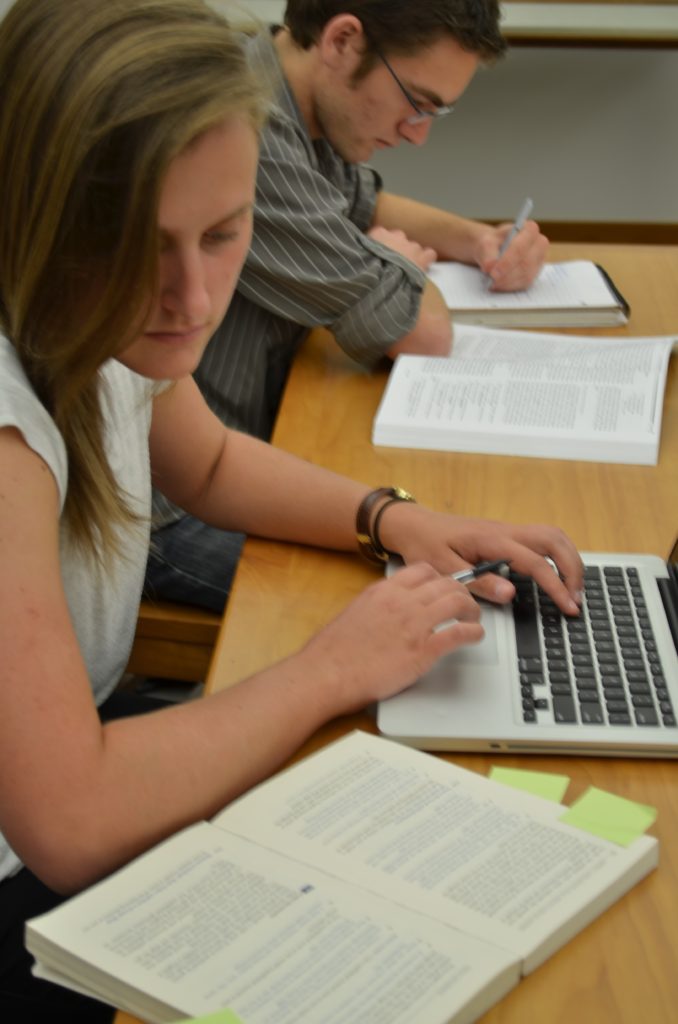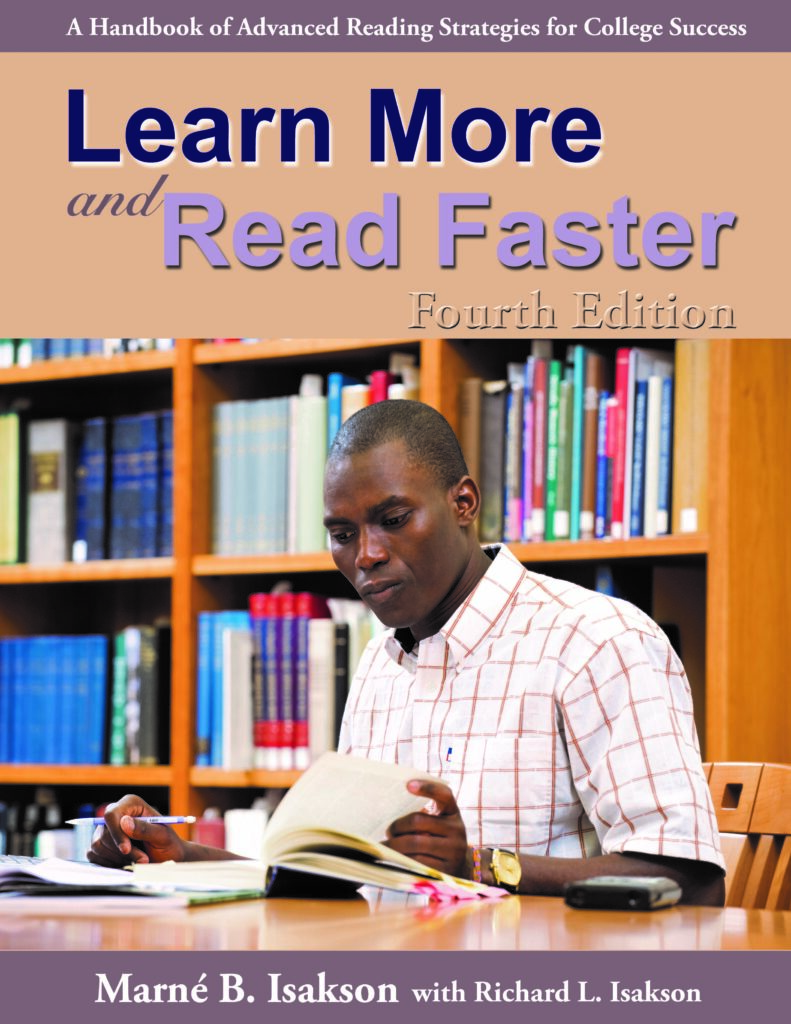HANDBOOKS
Two handbooks help readers read their academic texts strategically and metacognitively. They use Before, During, and After strategies to learn more thoroughly from their challenging texts. One handbook is advanced with 31 academic reading strategies and 10 speeding-up drills. The second handbook has 16 of the same strategies and 6 speeding-up drills. A pocketbook is also available.
Learn More & Read Faster: A Handbook of Advanced Reading Strategies for College Success, 4th edition
Purpose:
Handle your heavy reading loads in timely ways with solid understanding, metacognitive awareness, good retention, and critical and creative thinking.
Target Audiences:
Upperclassmen who have declared their majors, graduate students, professional school students, diligent underclassmen, and people in careers with lots of reading. This handbook is also used in our online courses and for the self-instructional guide.
Description:
Learn More & Read Faster: A Handbook of Advanced Reading Strategies for College Success teaches 31 academic reading strategies, the 16 deemed essential for “surviving” college reading plus 15 additional strategies for critical and creative reading and in-depth learning such as for close reading, exam reading, and research reading. Each strategy is explained (what, why, how, under what conditions to use it); examples are given; a ThinkSheet is provided for each strategy to guide you through the process initially; and additional useful information is provided such as tips to enhance the strategy, adaptations for reading electronic texts, ways to use it to increase your vocabulary, ways to push through to more scholarly thinking, comments by readers about using it, and figures/tables to increase understanding of the strategy.
The handbook has drills to help you increase your reading rate of academic texts. It also offers suggestions for record keeping to monitor progress; provides eight appendices including shared texts for demonstration and practice, a section about differences in reading processes based on the discipline, our model of the academic reading process; and has an in-depth glossary of 37 key concepts for understanding academic texts on a deep level. The goal of this handbook is to help you take a curious, “creative, critically intelligent, compassionate, and concerned” (K. Bain, 2012, p. 201) approach to learning from intriguing and important texts.
Click here to see Table of Contents for Learn More & Read Faster.
ISBN: 9781611650457 © 2021, 358 pages. Click here for ordering information.
Surviving College Reading: A Handbook of Essential Reading Strategies for College Success (2nd ed.)

Purpose:
To help readers learn and apply essential strategies with metacognitive awareness for completing reading assignments with understanding and retention, and in a timely way.
Target audiences:
College students wanting to learn the essential strategies of academic reading, college-bound high school students, and college populations such as English language learners, academically under-prepared students, or special-needs students. Also useful for tutors and academic advisers for what to suggest to readers who come to academic support centers for help.
Description:
Surviving College Reading: A Handbook of Essential Reading Strategies for College Success teaches 16 academic reading strategies, the strategies that our students say make the biggest different in helping them understand, remember, and finish reading in a timely manner. Each strategy is well explained (What, Why, How, Under What Conditions to use it); examples are given; a ThinkSheet is provided to guide you through the process initially; and additional useful information is provided such as how to adapt the strategy when reading electronic texts, how to apply each strategy to learning the key vocabulary for a course, what readers say about it, tips for using it well, and quotations to enhance understanding. Moreover, six speeding up drills can increase your reading rate of academic texts. The appendix includes an article about how to learn technical vocabulary for the long-term, and the book has an in-depth glossary of 30 key concepts, an understanding of which will enhance your ability to learn from academic texts. The handbook offers instructors record-keeping suggestions to monitor progress and provides some shared texts for demonstration and practice. The goal of this handbook is to help you build the skills and mindset to be a confident and competent learner of your academic texts.
Click here to see Table of Contents for Surviving College Reading
Information:
ISBN: 978-0-74093-259-5 © 2017 212 pages. Click here for ordering information.
A Brief Guide to Academic Reading for College, 3rd ed.
Purpose:
To provide a concise explanation of important strategies to help you focus, comprehend, remember, explore, and critically appraise the information in texts for your courses. To help you learn well from your hardest texts. If you took one of our courses, to remind you of what was learned so you can continue to adapt and benefit from these strategies.
Target Audiences:
College students desiring an overview of the strategies for learning well from academic texts.; students in the disciplines who have hard texts to learn from; students who have taken one of our courses.
Description:
A Brief Guide to Academic Reading for College, 3rd ed. gives short explanations of 27 academic reading strategies. This pocketbook devotes one page to explain a strategy and sometimes two strategies per page. Each explanation includes its purpose, why do it, important information to know about it, and how to do it. Click here for a sample page. To learn the strategies for the first time, the information in the handbook, Learn More and Read Faster: A Handbook of Advanced Reading Strategies for College Success, 4th edition, is highly recommended.
Click here to see Table of Contents for this pocketbook.
Information:
ISBN:9781611650198. © 2022 30 pages. Saddleback binding. 5.5″ x 8.5″ Click here for ordering information.
A Brief Guide to College Reading, International edition
Purpose:
This pocketbook provides a reminder of the 11 essential strategies to improve your abilities to read academic texts. You probably learned these earlier from the Handbook, in a workshop, or in a face-to-face class.
Target Audiences:
Students who are taking the non-credit face-to-face course; students who have taken one of our courses; college students in the disciplines as recommended by professors or advisors.
Description:
A Brief Guide to Academic Reading for College, 3rd ed. reminds you of 28 academic reading strategies. Click here for a sample page. This pocketbook devotes only one page to explaining a strategy and sometimes two strategies per page. To learn the strategies for the first time, we highly recommend you study the information in the handbook, Learn More and Read Faster: A Handbook of Advanced Reading Strategies for College Success, 4th edition.
Click here to see Table of Contents for the pocketbook.
Information:
ISBN:9781611661675 © 2022 13 pages. Order here.
COURSES
Learn powerful academic reading strategies: Take one of two types of courses: Credit-bearing and Non-Credit courses.
The credit-bearing courses are the best option for learning the strategies well and may be offered at your college or university. These accredited courses could be offered at your of institution of higher education. We offer a package for each course that includes suggested lesson plans, calendar/syllabus, teaching materials, power-point and video demonstrations, ThinkSheets to guide students through the strategies, progress charts, assessments, instructor training, and consultation.
Advanced Reading Strategies for College Success for upper classmen, graduate, students, and diligent lower classmen.
Surviving College Reading for under classmen, college-bound students, and students wanting/needing more support.
Contact us for more information about offering these courses at your college.
The non-credit courses are presented online.
If you cannot take one the courses but want to become a more strategic reader, follow our Self-Instruction Guide.
CREDIT-BEARING COURSES
Advanced Reading Strategies for College Success Course: 28 Strategies that Make a Difference
A course to teach readers to learn essential and scholarly, critical reading strategies, to apply them with metacognitive awareness, and to use flexible reading rates with their academic reading.
Surviving College Reading Course: 16 Strategies that Make a Difference
A course to teach readers essential academic reading strategies for surviving college reading, to apply them with metacognitive awareness, and to use flexible reading rates with their academic reading.
NON-CREDIT COURSES
People taking one of our online courses are likely to be from the following groups:
-
- College students who feel overwhelmed by their reading assignments and want to remove that sense of dread and instead learn from texts with enthused learning.
- College grads headed to graduate school or to professional school (medicine, law, dental, business, etc.) who feel they need a boost in their academic reading abilities to deal with the massive amounts of reading in store for them.
- High school students who want to read well for their college-prep, AP or IRB classes and to prepare in advance for the demands of college reading.
- Professionals already in their careers who want to keep abreast of their fields and meet the reading demands of their work.
- Teachers/Professors who want to help their students become more adept learners from academic texts.
- Adults who want to return to college but don’t feel ready.
- Others who want better ways to read-to-learn.
The courses teach strategies selected from the expert-reader research across many disciplines, as do the credit-bearing courses. These are the strategies excellent readers adapt to the ways of learning within their discipline and those they use consistently and seemingly naturally to learn from hard texts.
The strategies are easy to learn and can make a powerful difference in understanding, remembering, and being able to process in timely ways the concepts, ideas, and arguments in academic texts.
Online Courses: Surviving College Reading  and Academic Reading#1
and Academic Reading#1
What & How
This is currently offered in two formats:
An 8 to 10-week non-credit course with modules teaching the basic strategies for college success, geared for college students and college-bound students. This course is offered on-demand. https://www.isaksonliteracy.com
A 12 to 14-week non-credit online course, taken with a cohort of people, geared for instructors and professors. Click here for list of the modules and calendar template.
For both courses you do the following:
- Complete modules which usually take 45 to 120 minutes each at a pace of one to two modules per week .
- Use your own texts, the harder the better.
- Work through the lessons and interact with the instructor and any others taking the course with you, if any.
- Do the lessons at a convenient time for you within the week specified on the calendar if with a cohort of students.
- Learn through carefully researched and proven instructional methods: you recognize a problem, activate your prior knowledge and experience about the problem, read an explanation, watch a demonstration, try the strategy with a ThinkSheet to guide you through the process, reflect on the processes, share your experiences and insights using the strategy, and discuss with the instructor and group members (if any).
SELF INSTRUCTION
If the above course options are not feasible for your situation or are not available, you can use the handbook to teach yourself if you are committed and disciplined. The Self-Instructional Guides walk you through the process of learning the strategies on your own (and except for the handbooks and printing costs, they are free!)
Ten Lessons–Essential Academic Reading Strategies
Learn the few basic and most used strategies for becoming a good academic reader.
- Obtain several academic texts you need to read and learn from–informational texts, journal articles, manuals, whatever you are assigned to read for your classes.
- Purchase these:
- The handbook Learn More & Read Faster: A Handbook of Advanced Reading Strategies for College Success, 4th ed. Click here for ordering information.
- The pocketbook to use as a reminder after learning the strategies: A Brief Guide to College Reading, International Edition. Click here for ordering information.
- Download these materials:
- The Self-Instructional Guide: “Ten Lessons–Essential Academic Reading Strategies“
- ThinkSheets and other needed materials.
Thirty-two Lessons–the Complete Program for Learning Academic Reading Strategies
Learn the basic and the advanced academic reading strategies for becoming an expert academic reader. The lessons include the essential strategies and advanced critical and creative reading strategies, research reading, exam reading, disciplinary reading, 10 speeding-up drills, and everything else in the handbook to help you read the hardest texts you need and want to read.
- Obtain several academic texts you need to read and learn from–informational texts, journal articles, manuals, whatever you are assigned to read for your classes.
- Purchase these materials:
- The handbook Learn More & Read Faster: A Handbook of Advanced Reading Strategies for College Success, 4th ed. Click here for ordering information.
- A pacing device: Either one of the following two pacing tools work well to help you increase your reading speed. They both accomplish the same thing. Choose ONE of these:
- The Increase App: available for your smart phone at https://increaseapp.com. For questions, e-mail: support@increaseapp.com; cost: approximately $9.99. OR
- The ReadMate: a handheld device about the size of a small cassette player is not longer being produced, but you might be able to find a used one on the internet, eBay, etc. Click here to see a photo of it.
- The pocketbook to use as a reminder after learning the strategies: A Brief Guide to Academic Reading fo College Reading, 3rd Edition. Click here for ordering information.
- Download these materials:
- The Self-Instructional Guide: “Thirty-two Lessons–the Complete Program for Learning Academic Reading Strategies” Click here for access.
- ThinkSheets and other needed materials. Click this link for the complete program.
WORKSHOPS
What can you as professors or high school teachers suggest to students when they struggle with the readings you assign? We offer workshops to help you support students in learning well from your texts and in coming to class prepared and enthused to learn from you.
To support your efforts, we have videos of the strategies you could put on your learning management system and a pocketbook your students can use outside of class to improve as academic readers. The first three workshops described below settle along a continuum concerning time involved, number of strategies learned, and depth of learning the academic reading strategies. We can train facilitators to lead these workshops. Contact us.
Overview of Strategies 50-minute PRESENTATION
Target audiences: professors, high school teachers, students, or parents.
Purpose: to introduce key strategies that can make an immediate positive difference in reading academic texts well.
Description: TIME: 50-60 minutes. CONTENT: value of Layered Reading; six essential strategies–two Before reading strategies, two During reading strategies, and two After reading strategies. MATERIALS: a two-page handout, a passage we provide. METHOD: overview, explanation with brief demonstration, a few minutes to try several, debriefing the experiences, and application discussion geared to audience’s needs, Q&A.
Overview of Strategies 80 to 120-minute WORKSHOP
Target audience: Professors, high school teachers, or students.
Purpose: to learn and briefly try the key strategies and to discuss classroom applications and ways to encourage reading compliance.
Description: TIME: 80 to 120 minutes. CONTENT: same Workshop #1 above (Layered Reading, six essential strategies) but with more doing and discussing. MATERIALS: a four-page handout, participants bring a challenging text of their own. METHOD: overview, explanation, demonstration, coached practice on own texts and processing of the experiences, and brief discussion of classroom applications and ways to encourage reading compliance. Q&A.
Supporting Academic Reading in the Disciplines 12-hour WORKSHOP
Target audience: College Professors in departments or high school teachers.
Purposes: to promote the idea that teachers are the best ones to help students not only learn the content but also HOW to learn the content; to learn, then live, then adapt the academic reading strategies to the discipline’s ways of learning; to decide realistic ways to help students learn the strategies given every course’s severe time constraints; to create ways to encourage reading compliance; and to build and sustain professor’s capacity to support their students in reading the assigned texts efficiently and with deep, engaged learning.
Three Goals for the 12-hour Workshop Experience: Upon completion of this set of workshops, you should be able to:
- Learn and live each of the key strategies with your own professional reading so you can speak from personal experience of their procedures and value.
- Suggest the strategies to students using a minimum of class time but with strong effect on their reading for your class.
- Learn a variety of ways to encourage students to reading diligently so they come to class having read with engagement, inquiry, and deep learning. 90% prepared—feasible?
“Fundamentally, we want to promote deep, passionate, joyous, and creative learning” (Bain, 2012, What the Best College Students Do, p. 10) for the workshop participants and ultimately for their students. We desire that the teachers leave the workshop having created a plan they are excited about implementing to strengthen the abilities of their students to learn well and deeply from the reading materials they assign.
Description:
TIME: 12 hours of workshop time—can be spread across a semester, condensed into two days, or other configurations convenient for the audience. Homework time outside the workshop is to read assigned parts of the handbook and an article.
CONTENT: Principles for learning well from academic texts, 15 essential and scholarly strategies.
MATERIALS: a workshop packet, participants bring a challenging scholarly text of their own, a text they assign to students, their course syllabus, and our handbook Learn More & Read Faster, 4th ed.
DESCRIPTION: A series of nine highly interactive experiences where participants live the strategies by trying them on a text of their choosing. Workshop time is also used to process their learning, to coach participants as they practice the strategies, to explore how to promote the strategies with students, and to come up with viable ways to increase the probability that students actually read the important texts they need to read and with deep, long-lasting learning.
Workshop for College-bound High School Students
Target audience: high school students or recent high school graduates hoping to do well in college.
Purpose: to be introduced to, learn and try several essential academic reading strategies and to debrief their experiences with the strategies.
Description: TIME: 4 1/2 hours. CONTENT: 7 essential strategies taught and 4 more briefly introduced. MATERIALS: a handout, participants bring a challenging text of their own. METHOD: for each strategy: the problem the strategy solves, explanation, demonstration, coached practice on own texts, and debriefing discussion with Q&A.
[divider ] Back to Top


